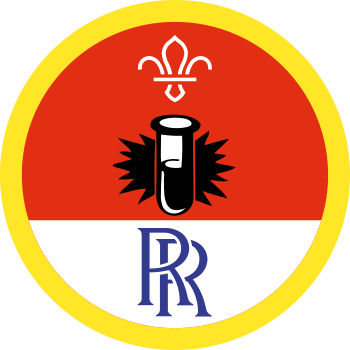
Make conductive dough
You’ll need
- Stove or hot plate
- Saucepan
- Protective equipment, such as heatproof gloves and tea towels
- A trivet
- A wooden spoon
- First aid kit, including for burns
- Fire extinguishing equipment, such as a fire extinguisher or fire blanket
- A jug
- A weighing scale
- Bowls for ingredients (optional)
- A tablespoon
- 230ml of water
- 160g of table salt
- 160g of plain flour
- 2 heaped tablespoons of cream of tartar
- 1 tablespoon of vegetable oil
- Electrical circuit battery pack and wires
- Electrical circuit components, such as a motor, a small (3V) LED bulb or a buzzer.
- Crocodile clips
- Pastry cutters
Before you begin
- Use the safety checklist to help you plan and risk assess your activity. There's also more guidance to help you carry out your risk assessment, including examples. Don’t forget to make sure all young people and adults involved in the activity know how to take part safely.
- Make sure you’ll have enough adult helpers. You may need some parents and carers to help if you’re short on helpers.
- You may want to pre-make the dough in this activity and focus on the circuit building.
Learning about conductors and insulators
- Gather everyone together and ask if anyone knows what a conductor or insulator is. If anyone does, let them explain.
- Tell everyone that some materials let electricity pass through them easily. These materials are known as electrical conductors. Ask if anyone knows a good conducting material.
- Explain that many metals, such as copper, iron and steel, are good electrical conductors. This is why the parts of electrical objects that need to let electricity pass through are always made of metal. For example, in a light bulb the metal filament conducts electricity and causes the light bulb to light up.
- Some materials don’t allow electricity to pass through them. These materials are known as electrical insulators. Ask if anyone knows an insulating material.
- Plastic, wood, glass and rubber are good electrical insulators, so this is why they are used to cover materials that carry electricity. The plastic covering that surrounds wires is an electrical insulator. It stops you from getting an electrical shock.
Making the dough
- Now, tell everyone you’re going to make a dough that can conduct electricity, then build an electric circuit.
- Ask if anyone knows what an electric circuit is. A circuit is a complete path around which electricity can flow. It must include a source of electricity, such as a battery. Materials that allow electric current to pass through them easily, the conductors, can be used to link the positive and negative ends of a battery, creating a circuit. In an open or broken circuit, there is a break along the line, and the current stops. In a closed or complete circuit, electric current can flow. When electric current flows it can be used by electrical appliances, such as light bulbs.
- Divide everyone into groups, making sure each group has at least one supervising, responsible adult.
- Give out the equipment and let each group find a safe place to work in together.
- Ask the group to measure out the ingredients.
- With adult supervision and help, one member in each group should add the water and the salt to the saucepan.
- Next, as a group, bring it to the boil, so it’s bubbling until most of the salt has dissolved. Remember to never touch the pan, the stove or the water, as they’ll be hot.
- Next, the supervising adult should help someone else to carefully add the flour, cream of tartar and oil into the pan. An adult could also do this step.
- Now, someone else, again with adult help, should continuously stir the mixture over a medium heat. Keep going until a dough ball forms.
- With heatproof gloves, an adult should carefully remove the pan from the heat and place it on a safe, heatproof surface, away from young people.
- Next, turn off the heat source.
- When the dough’s cooled, an adult should place the dough onto a floured work surface. You may want to use heatproof tongs.
- Now each member in each group should take it in turns to knead the dough ball. Keep going until it reaches a firm consistency.
- When it’s ready, you can use the pastry cutters to make the dough into interesting shapes.
- Now, you can all begin experimenting with circuits.
Making the circuits
- When the dough is ready, first make sure the battery pack is switched off. Then, the group should roll two small balls of dough and put one on each of the connectors of the battery pack. There should be one red wire (the positive) and one black wire (the negative).
- Next, they should take an electrical component and fix each of its legs or wires into one of the dough balls. For an LED Bulb, the longer leg is the positive leg and should go in the same dough ball as the positive (red) wire and the shorter, negative leg should go into the same ball as the negative (black) wire. For wires, there should be one red wire (the positive) and one black wire (the negative).
- When you’re ready, turn your battery pack on and the light or other electrical competent should work.
- Encourage everyone to keep experimenting. However, always remember to turn the battery pack off while creating your circuit. For example, they could expand your circuit using crocodile clips, connecting the clip to the dough rather than the element, and adding in other electrical components. You could add a motor, a buzzer, more bulbs or a switch.
- Ask everyone how they think the dough conducts electricity. Let a few people, who are happy and comfortable to, share their thoughts or answer.
- Explain that the dough contains water, which is a conductor. Water has a low resistance to electricity, meaning that electricity can pass through water more easily. The presence of the water in the dough, even in the dough’s solid form, means that electricity can pass through the dough. However, what makes the dough an even better conductor is the salt in the water. Salt molecules are made of sodium and chlorine ions. An ion is an atom that has an electric charge, each of which conducts electricity.
Reflection
This activity was all about conducting electricity. Can you remember why the dough conducted electricity? Can you think about anything else that conducts electricity? What materials make a good or bad conductor?
In this activity, we created a circuit. Can you think of anywhere else there may be an electric circuit? How can we stay safe when using electricity or electric circuits, or when making them?
Some science experiments work easier or quicker than others, and that is part of the fun. Was it easy or hard to make this experiment work? What did you experiment with? What factors did you change and what did you keep the same?
Finally, this activity was all about teamwork. How did you work as a team? Did everyone get the chance to have a go or input in the activity? How did you make it fair? And how did you communicate, did anyone take over or did you make sure everyone had the chance to speak and contribute?
Safety
All activities must be safely managed. You must complete a thorough risk assessment and take appropriate steps to reduce risk. Use the safety checklist to help you plan and risk assess your activity. Always get approval for the activity, and have suitable supervision and an InTouch process.
- Electrical equipment
Inspect cables for any damage before each use. A responsible adult should supervise people using equipment, and people should follow instructions on how to use them correctly and safely. They should be properly maintained and stored. Be extra cautious of trailing cables and water when using electric equipment.
- Hand and electric tools
Inspect tools for any damage before each use. An adult should supervise people using tools, and people should follow instructions on how to use them correctly and safely. Tools should be properly maintained and kept sharp.
Use an appropriate surface and make sure materials are stable and supported when you’re working on them. You should cut and drill away from the body and in an area clear of other people. Be extra cautious of trailing cables and water when using electric tools. Always use a cordless tool if one’s available.
- Electronics
Remove any equipment you’re working on from the power source before you begin. Never assume the power circuit’s off – test it with a voltmeter (and then test it again to be sure). Only connect power to a circuit once you’ve finished working on it and have checked your work. Make sure your circuit isn’t overloaded, and return any covers you’ve removed.
Make sure that all electronics equipment is properly grounded. Use the right electronics tools, and always replace damaged equipment (for example, replace cables rather than repairing them with insulating tape). Always have safety equipment including a fire extinguisher, basic first aid kit, and mobile phone nearby.
- Science
Supervise young people, and only do science activities that are advised and age appropriate for your section. Test activities first, to make sure you’re confident you can lead them safely. Use protective clothing where necessary.
- Craft: Unusual substances
Supervise young people appropriately when they’re using unusual substances, such as powdered paint, ash or dirt. Be aware of any medical conditions that could be affected by what’s being used. Make sure you follow all relevant safety guidance or manufacturers guidelines, where available. Make sure you dispose of it appropriately too, in line with safety guidance.
- Cooking
Teach young people how to use cooking equipment safely. Supervise them appropriately throughout. Make sure it’s safe to use and follow manufacturers’ guidelines for use.
- Hot items and hot water
Kettles, cookers and microwave ovens produce a lot of heat by the very nature of them. Caution is needed when in contact with items that have been heated and young people should use them under adult supervision. Use on a suitable surface, protecting it if necessary. Never leave hot items unattended and make sure there’s a nearby first aid kit, with items to treat burns/scalds.
Some people may have textile sensory sensitivities, so be aware of this when asking them to use their hands and get messy. You may want to have rubber gloves or extra spoons on hand for those who need.
All Scout activities should be inclusive and accessible.

